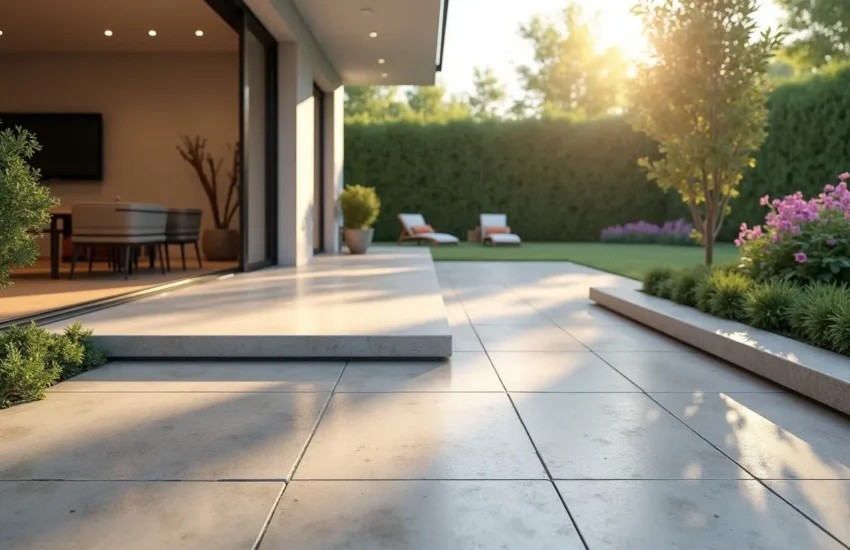
A family-friendly landscape can transform your backyard into a vibrant space where everyone can explore, learn, and grow. It can invite children to discover the wonders of nature, give adults a cozy spot for relaxation, and offer pets a safe place to play. This approach also emphasizes sustainability, creativity, and harmony, allowing each family member to connect with the outdoors in meaningful ways.
Contents
- 1 Designing Kid-Friendly Gardens For Outdoor Family Fun
- 2 Embracing Nature Play Areas
- 3 Inclusive Gardens For Family Gatherings
- 4 Safe Gardening Practices And Environmental Education
- 5 Combining Outdoor Activities With Playful Landscaping
- 6 Integrating Pets And Child-Safe Landscaping
- 7 Family Bonding Outdoors Through Green Play Spaces
- 8 Planning For Growth And Flexibility
- 9 Making The Most Of Your Outdoor Space
Designing Kid-Friendly Gardens For Outdoor Family Fun
Gardens built for kids often blend bright colors, easy-to-navigate paths, and interactive elements. By choosing plant varieties that are both non-toxic and simple to maintain, you create a safe space that sparks curiosity. Focus on native flowers and shrubs that can survive local weather changes with minimal upkeep. Doing so not only saves time but also cultivates a love for nature at an early age.
Kids typically enjoy playing and learning outside, so consider adding features like a small sandbox, a child-size bench, or an herb patch they can tend. When children take ownership of certain tasks, it boosts their confidence. This encourages them to explore even more outdoor activities for kids, such as nature scavenger hunts or flower-pressing projects. You improve the garden’s overall appeal while nurturing children’s sense of responsibility.
Adding Interactive Elements
Engaging elements can help children develop sensory and motor skills. A raised garden bed for vegetables is an excellent starting point. This structure allows them to dig, plant, and water with ease. You can also add wind chimes or decorative stepping stones, which add color and sound to the space. These minor touches support kid-friendly gardens by offering hands-on interaction.
Embracing Nature Play Areas
Nature play areas merge fun with natural materials. Instead of standard plastic structures, use logs, stones, and mulch to present climbing, balancing, and imaginative play options. This approach to playful landscaping taps into a child’s innate desire for exploration while remaining eco-friendly.
Designing a child-safe landscaping plan involves thinking about soft landings, such as using wood chips or rubber mulch to cushion falls. Safe playground design strategies protect little ones from scrapes or injuries. Dense shrubs, trees, or small fences can define different play zones, ensuring supervised adventures. Incorporating water features for families, like a shallow stream or a child-proof fountain, offers multi-sensory learning and adds visual charm to your yard.
Balancing Risk And Safety
Natural play environments can still be secure when properly planned. Keep a watchful eye on heights, water depth, and edges. If you decide to add climbing structures, ensure they meet local safety requirements. You could also include shade structures to prevent sunburn and dehydration on hot days. This blend of fun and caution enriches everyone’s experience in the yard.
Inclusive Gardens For Family Gatherings
A welcoming outdoor space should accommodate not just children but also friends, neighbors, and grandparents. Designing a multi-generational garden starts with promoting easy movement. Wide, accessible garden paths are ideal for strollers or wheelchairs. A sturdy seating area with benches or chairs set at different heights ensures everyone finds a comfortable spot. This inclusive approach fosters quality family time in one cohesive space.
When planning for family gatherings, think about creating a designated area for casual meals or barbecues. A well-designed patio or deck can serve as a hub for conversation and laughter. Add string lights or soft solar lighting for outdoor living spaces that remain inviting after dark. You can even set up a small fire pit away from high-traffic zones for toasty marshmallow-roasting sessions, which appeals to folks of every age.
Encouraging Community Connections
If you enjoy neighborhood interaction, consider joining or supporting community gardens. These shared spaces often welcome volunteers of all skill levels and backgrounds, making them perfect for meeting like-minded families. Working in a communal environment supports environmental education by showing younger members how gardening benefits entire communities. It also highlights the importance of teamwork, respect for the environment, and resource-sharing.
Safe Gardening Practices And Environmental Education
Teaching safe gardening practices to children is simpler when you demonstrate them in your own backyard. Emphasize proper tool usage, handwashing, and mindful planting. By explaining why some plants require more water or sunlight than others, you nurture curiosity. You can also talk about composting and recycling, helping kids see how everyday waste can enrich the soil instead of ending up in landfills.
An eco-friendly landscaping plan leverages organic fertilizers, natural pest control methods, and drought-tolerant plant selections. Children will learn that nature rewards responsible behavior. Such discussions feed into broader lessons about biodiversity, conservation, and sustainable living, making the landscape more than a pretty backdrop—it becomes a classroom in its own right.
Seasonal Plant Choices
Rotate plant varieties based on seasonal plant choices so there is something interesting to see throughout the year. Spring flowers, summer vegetables, and autumn foliage create an ever-changing tapestry for your family garden design. In colder months, you could try evergreens or winter-blooming shrubs to keep the space lively. Each season becomes its own lesson, fostering a year-round commitment to environmental awareness.
Combining Outdoor Activities With Playful Landscaping
Families bond best when there is plenty to do. Think about adding a dedicated lawn area for ball games or a quiet corner for crafts. When blending playful landscaping with functional zones, every inch of your yard can promote fun without overlooking safety. If you enjoy backyard entertaining spaces, plan an area that can easily transform from a kid’s play zone to an adult gathering spot in the evening.
You might also set aside a cozy reading nook under a tree. Add a hammock or comfortable outdoor cushions for a bit of shade and relaxation. Meanwhile, a green play space with a few potted plants or raised beds can keep little hands engaged. This flexible approach addresses multiple needs without overcrowding the yard.
Privacy Screens In Gardens
Sometimes, families want a sense of seclusion, especially if they live in dense neighborhoods. Installing privacy screens in gardens can create a calm retreat. Living walls made from climbing vines or tall shrubs look natural and block out nosy neighbors. For a more modern appearance, wooden slats or metal lattices can be adorned with creeping plants. This added privacy shields your family’s activities, from quiet reading sessions to boisterous games.
Integrating Pets And Child-Safe Landscaping
Many households have dogs or cats, so landscaping with pets in mind is often crucial. Pet-friendly yards feature non-toxic grasses, sturdy fencing, and shaded nooks where animals can rest. You can install pathways that double as a perimeter for your pets to patrol. This approach keeps them happy and reduces wear and tear on your lawn. It also ensures minimal conflict between children and pets, especially if both share the space.
Child-safe landscaping goes beyond plants and fencing. Check for hidden hazards like sharp edges, exposed nails, or standing water where insects might breed. Keep garden tools and chemicals locked away in a secure shed. Pet toys, too, should have a designated spot to prevent tripping or confusion with children’s items. By being proactive, you maintain a yard that allows everyone to run around and have fun without worry.
Water Features And Lighting For Outdoor Safety
Small ponds or fountains can add a tranquil feel to your yard. Be sure to monitor water depth and consider installing child-safe gates if necessary. Reflective pond surfaces can draw children in, so always prioritize safety barriers. Pair these features with lighting for outdoor safety, ensuring that walkways and edges remain visible after sundown. LED lights along paths or solar-powered lanterns can help people navigate the yard without stepping on plants or tripping.
Family Bonding Outdoors Through Green Play Spaces
Plenty of parents want to see their children spending more time outside. Green play spaces encourage kids to step away from screens and reconnect with nature. Consider building low-maintenance plants into your design, so the garden’s upkeep doesn’t feel overwhelming. Shade-loving ferns or hardy succulents make appealing additions in various spots.
Invite the family to try seed planting, watering schedules, or a simple gardening journal to track daily changes. These rituals foster a sense of teamwork. Younger children can learn to identify shapes and colors in blossoms, while teens might try a vegetable-growing project. Such activities stir creativity and curiosity, turning the act of tending a garden into a fun bonding experience.
Encouraging Family Picnics
Nothing says outdoor family fun like a good picnic. Set aside a lawn area for blankets or invest in a sturdy outdoor table and chairs. If you have a grill or fire pit, that’s another excuse to gather for hot dogs or roasted veggies. Keep a basket ready for impromptu snacks, and make sure there is a level, child-friendly surface for beverages and dishes. Simple gestures like these transform a regular afternoon into something memorable.
Planning For Growth And Flexibility
Family needs evolve over time. Toddlers become teenagers, people might move in or out, and pets come and go. A flexible landscape design supports these shifts with minimal fuss. Focus on modular features that can be removed or upgraded as your children grow. Maybe the climbing frame can become a lounge area, or raised beds can transform into flowerbeds that brighten the yard during the teenage years.
Accessible Garden Paths And Play Equipment Installation
As your family grows, adding or enhancing walkway locations can help in moving around your yard. Accessible garden paths made from pavers or stone slabs keep muddy feet at bay. They also provide a firm surface for strollers and wheelchairs if needed. Additionally, reflect on safe play equipment installation to accommodate changing tastes, from toddler swings to a small basketball hoop. Adapting to family changes helps your outdoor space feel relevant for years to come.
Making The Most Of Your Outdoor Space
Every family has different interests. Some might want a tranquil spot for reading, while others crave an area for sports. Your family-friendly landscape becomes a living extension of the home when it reflects those personal preferences. If you build privacy, safety, and fun into the design, you can’t go wrong. Splashes of color, innovative play features, and pet-friendly corners create a space where memories blossom.
Whether it’s sharing garden chores, hosting neighbors for a casual cookout, or simply lying on the grass for stargazing, your yard can play a central role in family bonding outdoors. With thoughtful planning, you cultivate a safe, multifunctional setting that encourages everyone to step outside and enjoy each other’s company in a naturally beautiful environment.



Leave a Reply
You must be logged in to post a comment.